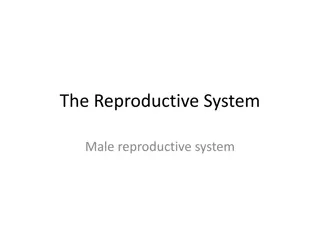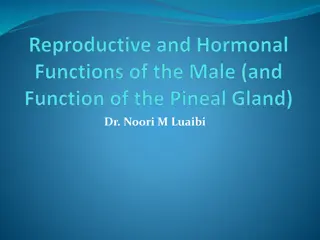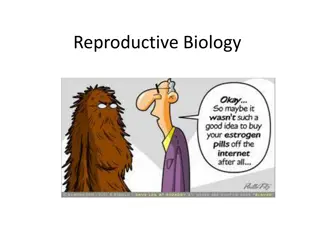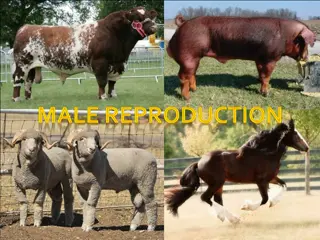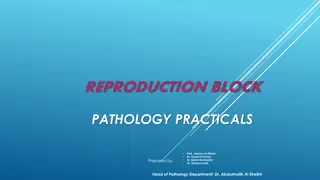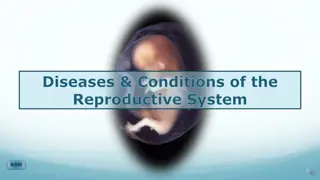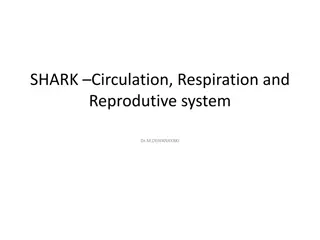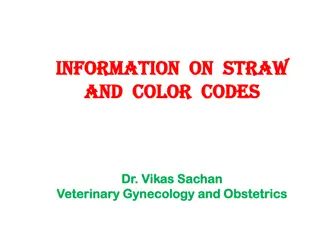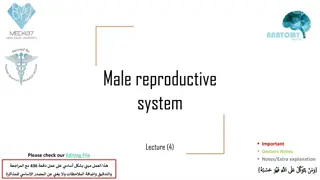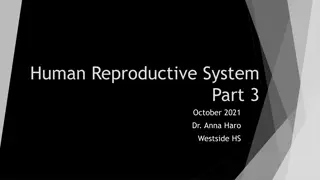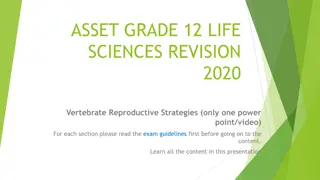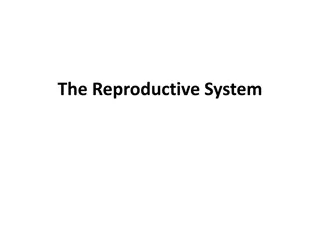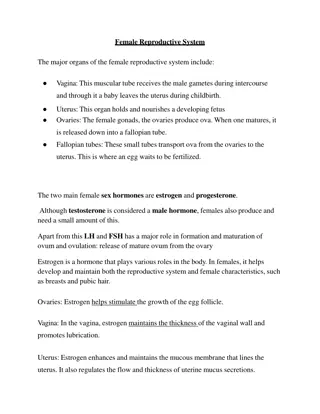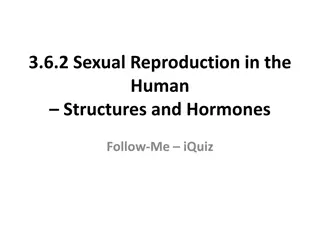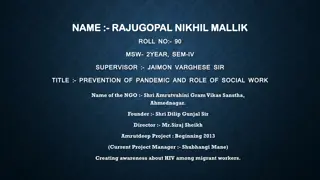Understanding the Male Reproductive System: An Overview by Dr. Vikas Sachan
Exploring the male reproductive system anatomy, including the testes, scrotum, reproductive ducts, and accessory sex glands, highlighting the production of sperm and male sex hormones. The role of primary and secondary sex organs, such as the epididymis, vas deferens, urethra, and penis, along with accessory sex glands like seminal vesicles, prostate, and bulbourethral glands, is discussed. Details about the scrotum, its layers, position, and function in thermoregulation are also covered.
Download Presentation

Please find below an Image/Link to download the presentation.
The content on the website is provided AS IS for your information and personal use only. It may not be sold, licensed, or shared on other websites without obtaining consent from the author. Download presentation by click this link. If you encounter any issues during the download, it is possible that the publisher has removed the file from their server.
E N D
Presentation Transcript
Male Male reproductive system reproductive system (Anatomy) (Anatomy) - - Dr. Dr. Vikas Vikas Sachan Sachan
- The male reproduction system testes, scrotum, reproductive ducts, accessory sex glands, prepuce and penis - Production of - Spermatozoas Male sex hormone -Primary sex organs Testicles - Secondary sex organs (ductus system)- Epididymis, Vas deference, urethra, penis - Accessory sex glands Seminal vesicles, prostate and bulbo-urethral glands/cowpers gland
- SCROTUM SCROTUM . Cutaneous pouch . Encloses the testis . Testes fix by scrotal ligament . Scrotal hairs (except buck, ram, stallion and tom)
- Scrotal position Caudal to thighs Boar and Tom Between the thighs All others . Thermoregulation of testes . Sebaceous and sweat glands (Stallion, dog)
- SCROTUM LAYERS (outward to inward) 1. Epidermis 2. Dermis 3. Tunica dartos (fibroelastic CT & smooth muscles) 4. Tunica vaginalis communis/ reflexa (Extension of parietal peritoneum) 5. Vaginal process/cavity (space in between) 6. Tunica vaginalis propria (Extension of visceral peritoneum) 7. Tunica albuginea (fibrous layer with some smooth muscles) 8. Tunica vasculosa (layer with blood vessels)
- Tunica dartos - Form intertesticular septum - Stallion scrotum - short and non-pendulous - Testes in camel - non pendulous scrotum (in perineal region)
- The ductus system (in to out) : Seminiferous tubules Rete testes Efferent duct Caput epididymis Corpus epididymis Cauda epididymis Vas deferense Ampulla Pelvic urethra Penile urethra (in penis) . Exit
- SEMINIFEROUS TUBULES SEMINIFEROUS TUBULES Extension of tunica albuginea - Dividing testicular parenchyma into lobules (encloses seminiferous tubules) - Joins at mediastinum - Seminiferous tubules - Highly convoluted & Unbranched - Open at both ends - 75% of total testicular mass - They Have - Somatic sertoli cells/sustentacular/nurse - Sperm producing germ cells (spermatogonial germ cell line).
- The sertoli cells - Enrico Sertoli - The leydig cells - Franz Leydig. - Sertoli cells secretes mullerian inhibiting factor/hormone (MIH) (inhibite paramesonephric or mullerian duct) - The number of sertoli cells doesn t increase after puberty i.e. it limits the spermiogenesis or spermiogenic yield. - Sertoli cells form blood testes barrier just before the puberty to separate differentiating germ cells from blood circulation.
- Interstitial space (out of Sem. tub.) Leydig cells (interstitial cells) Blood vessels & Lymphatics - In ram leydig cells are found in clusters around blood vessels. - Length of seminiferous tubules : Boar 6 Km Bull 5 Km Ram 4 Km Dog 150 m Tom 25 m
- RETE TESTES RETE TESTES (in mediastinum) Seminiferous tubules Collecting tubules Rete testes Vas efferens - Lined by non secretory cuboidal epithelial cells
- TESTES TESTES (paired male gonads) - In scrotum at inguinal region - With help of tunics and spermatic cord - Covered with extra-abdominal tunic - Tunica vaginalis albugenia .vasculosa - Fluid in vaginal process - Movement of testis within scrotum - Plane of testes : Horizontal Stallion Vertical Cattle, ram, buck Oblique Boar, Dog, Tom
Testicular diameter Bull 5-9 cm Stallion 4-8 cm Ram and Buck 4-7 cm Boar 5-9 cm Dog 1-3 cm Tom 0.7 1.5 cm Shape of testes Oval stallion Elliptical boar Elongates oval bull, ram Round to oval Dog, Tom
- Size of testes varies throughout the year in seasonal breeder e.g. ram, stallion, camel - Weight of testis Bull 200-500 gm Ram and buck 200-400 gm Stallion 150-300 gm Boar 500-800 gm Dog 8-15 gm - In buffalo bull testes and scrotum are smaller and the penile sheath is less pendulous than cattle bull.
- Testes Endocrine Production of testosterone (By leydig cells .. LH/ICSH) Exocrine Spermatogenesis (FSH & testosterone) - Body weight .. positively correlated with testicular weight, testicular volume, total epididymal mass, total scrotal width - Castration (Removal of testicles) Reduces aggressive behavior of male animal Rreduces the boar taint
- Cremester Cremester muscle -Internal abdominal oblique muscle to tunica vaginalis propria muscle - Loosening & Raising of testes - In response to environmental temperature any abnormal stimulus is the - To maintain the testicular temperature - Retracting the testes within abdomen (Elephant, deer, and rabbit etc during their non breeding season)
- - Testes (in scrotum with help of spermatic cord) Spermatic cord comprises of . Internal spermatic artery . Spermatic veins (pampiniform plexus) . Lymphatic vessels . Autonomic nerves from renal and mesenteric plexus . Internal cremester muscle . Tunica vaginalis propria . Vas deferens - Mesorchium & mesepididymis
- - EFFERENT DUCTULES EFFERENT DUCTULES (Vas efferens or ductus efferens) - Connect rete testes to epididymis - 13 to 20 in numbers in bull - 13 to 15 in stallion - Spermatophagy (also in epididymis)
- EPIDIDYMIS EPIDIDYMIS - Highly convoluted tube - Firmer than testes in consistency - Head (caput), Body (corpus), tail (cauda) - lined by circular muscle fibre layer - Pseudosatrtified columnar cell layer - Histologically ..three parts - (not related to caput, corpus and cauda). - Large kinocilia & steriocelia with widen lumen - Medusa cells in the semen - Ciliated cells from caput epididymis.
- In Stallion and dog caput epididymis situated cranially, corpus epididymis dorsally and cauda epididymis caudally to testicle while in ruminants caput, corpus and cauda epididymis is situated dorsally, caudally and ventrally to testicle respectively. -Length of epididymis Bull 30-36 m 10 days Ram 50 m .. 13 to 15 days Boar 50-54 m 10 to 12 days Stallion 20 m 8 to 11 days
1. Absorption Absorption - In caput and cauda epididymis (90%) - Increases sperm concentration. 2. 2. Secretion Secretion - To maintain sperm viability during storage - Max protein secretion occurs in caput - Sperm flagellar activity, metabolic process, motility and fertilization capacity - Sialic acid, Carnitine, GPC - Immobilin, Quescent factor (in bull) - 5 reducatse in initial segment (T .DHT)
3. Storage Storage (cauda epididymis) Stores matured sperms (extended viability) 50% of extragonadal sperm (66% in stallion) 75% of total epididymal sperms Nearly 75000 million sperms 4. 4. Maturation Maturation (caput and corpus epididymis) PCd into DCD Motility and fertilizing capacity - Modification - Surface glycoproteins (sperm pm) - Reduce surface immunogenicity - Enhance ability to bind with zona pellucida
- Luminal environment & cool temperature in the cauda epididymis - Sperms are maintained in a protected, (quiescent state) - Fertility of sperms More in cauda epididymis 5. 5. Transportation Transportation - Capable to motile in cauda epididymis - Passive (non motile in caput epididymis) - Cilias and peristalsis of smooth muscles
- Vas deferens - Lined with pseudostratified epithelium - Lined with non ciliated cell - Little secretion - Joins epididymis to pelvic urethra - Temporary reservoir for sperm - Mesoductus deferens (running in the sp. cord) - Terminal swollen part ampullae (due to the abundance of ampullar glands) - Ampullae colliculus seminalis pelvic urethra
- AMPULLA AMPULLA - temporary sperm reservoir - Well developed in stallion - Very small/absent in dog, tom and boar - Stallion - Ergotheionine (an antioxidant) by ampulla and seminal vesicle - Uterus masculanis (utriculus prostaticus), (Remnant of paramesonephric duct situated between ampullae and vas deferens)
- SEMINAL VESICLE SEMINAL VESICLE - Predominant vesicular gland in bulls - About 50% of total seminal plasma - Situated near neck of urinary bladder - . lobulated and paired bull and ram . Bag like boar . Smooth & pear/pyriform stallion . Absent tom, dog and camel - In stallion .more bladder like structure and justified as seminal vesicle
- Vesicular secretion in bull Riboflavin (yellow coloration of semen) Inositol (osmoregulator) in boar Ergothionine (antioxidant) in boar Gel portion of stallion semen - Seminal vesicle secretes citric acid, fructose, ascorbic acid, inositol, ergothioneine, riboflavin, KHCO3, Bovine seminal plasma protein (BSP), prostaglandin etc.
- PROSTATE GLAND PROSTATE GLAND - Unpaired gland - Around urethra (at neck of urinary bladder) - Pars propria and pars disseminate in bull - Joined by isthmus in stallion - In ram prostate has no body (pars propria) - Only gland in dog (very small in tom) - Size of this gland increases with age (It pushes the freely movable urinary bladder from the pelvis into the abdomen) - Castration - Atrophy of the prostate (androgen dependent organ)
- Secretion of prostate gland - Acidic secretion (pH 6.5) - Lot of enzymes (proteinase, phosphatase, glycosidase, nucleases, nucleotidase etc) - anti-agglutinin - Zn and Cl and citric acid (in canines)
- COWPERS GLAND COWPERS GLAND (Bulbourethral gland) - Paired glands - At both side of pelvic urethra (at the level of ischiatic arc) (embedded in bulbospongiosus muscle) - Shape Ovoid - bull, ram and stallion Cylindrical - boar (most prominent gland) Absent - dogs (prominent in tom) - Driblings - (urethra cleansing fluid) - Gel portion of boar semen (Vaginal plug/seal after mating Sialomucin)
- URETHRA URETHRA - Pelvic (on pelvic floor) - Bulb or urethral isthmus (bending on ischiatic arc) - Penile (in the penis) - Common passage for urine and semen - Urethral glands - Present in boar Absent in bulls
- PENIS PENIS - Muscular and cylindrical copulatory organ - Two dorso lateral corpus cavernosum penis (CCP) muscles - One ventrally situated corpus spongiosum (CSP) muscles - CCP ... Tunica albuginea Ischiocavernosus (erector penis) muscle - CSP surrounds the pelvic and penile urethra. Covered by bulbospongiosus muscle (emptying the penile urethra)
- Spiral penis Boar - Penis - Sigmoid flexure (maintains the desired length of penis) - Post scrotal in bull and ram - Prescrotal in boar and camel - Absent in stallion - Retractor penis muscles (paired) - Smooth muscles (dorsal apical ligament of penis to sacral or 1st/2nd coccygeal vertebra) - Draw/retract back the penis in prepuce
- Penis may be : 1. Fibroelastic type - Lesser erectile tissue - More fibroelastic tissue - Less blood accumulation (small cavernous space) - e.g. bull, ram, camel and boar. 2. Musculo vascular type - More erectile tissue - More blood accumulation (bigger cavernous space) - e.g. stallion, dog, tom.
- Length of penis Bull 36 inches Ram 30 cm Stallion 50 cm Boar 50-55 cm - Erectile tissue are more in stallion than bull penis but retractor penis muscles are stronger in bull than stallion. - Stallion penis - Urethral process in fossa glandis, prepucial ring and urethral sinus/diverticulum - Smegma .Infectious material in urethral sinus - Urethral process is also character of ram penis
- Terminal / apical part of penis - Glans penis - Absent in boar and tom - Glans penis in dog has two parts : - Bulbus glandis and pars longa glandis - Both have erectile tissues - Cranial portion of dog penis : a bone called as os penis/baculum - Ventral groove of os penis urethra - Os penis - intromission before complete penile erection
- Tom penis - Points posteriorly in the relaxed stage - No bulbus glandis - No glans penis - No / short os penis. - Tom - Keratinized papillae/spines (100-120) - Spines are developed fully at puberty - Release of LH at coitus - Cat cry
- In dog, During penile erection - Pressure increases in CSP first then in CCP - More arterial flow (relax smooth muscles in CCP) - Less venous flow (compression by the ischiourethralis muscle) - Twisting at 180 degrees - Venous occlusion - Maintenance of erection - Swollen bulbus glandis - Copulatory lock - Normalization of the penis - Reduced hydrostatic blood pressure
- PREPUCE PREPUCE - Penile integument (modified skin over penis) - Invaginated fold of skin over penis - Prepucial orifice or prepucial osteum - Long and tough preputial hairs in bull - In bull, prepucial muscles - Protractor and Retractor prepucial muscles (drawing prepucial opening forward/backward)
- Stallion - double folded prepuce (wax like secretion beans at outer fold) - Boar - Preputial diverticulum (pouch) (at dorsal to prepucial orifice..dead cells/debris) (Pheromone restricted sow movement at coitus - Swine and ruminants urinate inside the prepuce - Horses, dogs and tom urinate out of prepuce
- Peristaltic action of urethralis muscle - Transport of urine or semen - Male camel - Poll glands - At back of neck near the poll - Activated after sexual maturity - Dark brown secretion . pheromones - Attractive to female in breeding season


